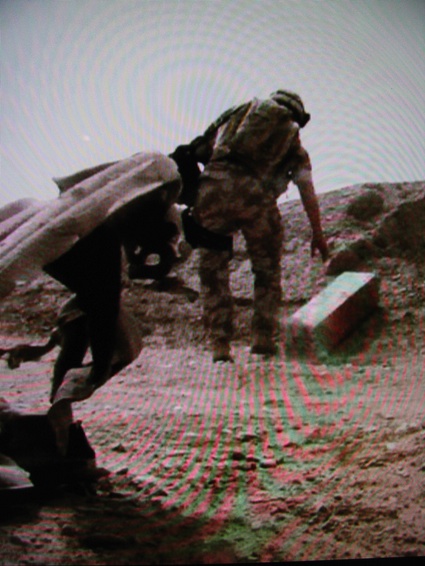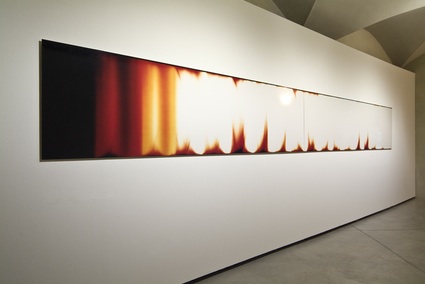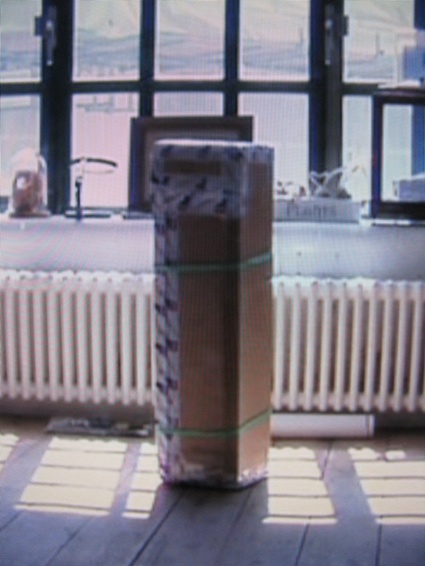I spent quite a bit of virtual ink on Manipulating Reality, a show that closed about a week ago at CCCS in Florence: Community Performance in Google Street View and 20.12.53 – 10.08.04.
This exhibition explored the way photographic images and videos represent reality as much as they can construct and betray it. One of its section was dedicated entirely to the treatment of images in the context of war.
 Adam Broomberg / Oliver Chanarin, 01-07, The Day Nobody Died, 2008
Adam Broomberg / Oliver Chanarin, 01-07, The Day Nobody Died, 2008
As James der Derian notes in his essay for the exhibition catalog: No State or state of mind can exercise full authority in the contemporary infosphere – which of course does not stop many from trying.
Images and politics are of course intimately intertwined. A clamorous example is offered by the German and Italian fascist movements in the 1930s. Inspired by the techniques of agitprop of the Russian Revolution, both governments used the relatively new media that were photography, radio and film to bolster their power through visual messages where propaganda and reality appeared to be one and only.
The issue was brought to the public attention more recently when the Pentagon imposed a strict blackout on media coverage of US soldiers’ coffins returning from Iraq (a censorship which seemed to extend to art portraits of living but reclining soldiers.) The ban, in force since the Persian Gulf war, was eased last year.
Artists Adam Broomberg and Oliver Chanarin followed the British army in Afghanistan as embedded photo reporters in June 2008. Embedded reporters are expected to ‘document’ the conflict while complying with the rigid directives of military command. Only the images that make it through their censorship process are published.
 The Brother’s Suicide, 2008. Exhibition views. © Centro di Cultura Contemporanea Strozzina, Firenze; Valentina Muscedra
The Brother’s Suicide, 2008. Exhibition views. © Centro di Cultura Contemporanea Strozzina, Firenze; Valentina Muscedra
Instead of running after bullets and casualties, Broomberg and Chanarin exposed a roll of 76.2 cm wide and 6 m long photographic paper to the sun for twenty seconds every day. The result, titled The Brother’s Suicide, is a series of abstract, mostly white images, with colourful marks where the light and the heat triggered a chemical reaction on the paper.
The next step of their work in Afghanistan is The Day Nobody Died, a video that traces the return of the cardboard box containing the roll of photographic paper. The artists followed the soldiers and filmed them as they had to load and unloading the roll of photographic paper from one military base to another. The same gestures are repeated as the soldiers and the box step inside on Chinooks, planes, buses, tanks and jeeps. The object bore no meaning nor probably any sense for the soldiers who become the involuntary protagonists of an absurd performance encapsulating the repetitive nature of military life outside the battleground. A touching and quirky moment in the video sees the soldiers watching the reality show Big Brother under a military tent, with the big cardboard box ‘sitting’ among them.
 Adam Broomberg / Oliver Chanarin, 01-07, The Day Nobody Died, 2008
Adam Broomberg / Oliver Chanarin, 01-07, The Day Nobody Died, 2008
The choice of communicating their experience on the war front through abstract and formalistic representation might seem almost irrational. When it is impossible and even forbidden to faithfully communicate the pain and horror of the personal tragedy of soldiers waiting for the moment to fight or die, The Brother’s Suicide and The Day Nobody Died force us to reflect and imagine what we do not see and what we are not told.
What Broomberg and Chanarin seek to demonstrate with this paradoxical work of “anti-documentation” is that their images are equivalent in terms of truth content to the photographs of embedded reporters approved by military censorship. Their abstract painting of light bears witness to the reality of the conflict in the same almost paradoxical way as the work of the war photographers, which in any case does not present the truth.
